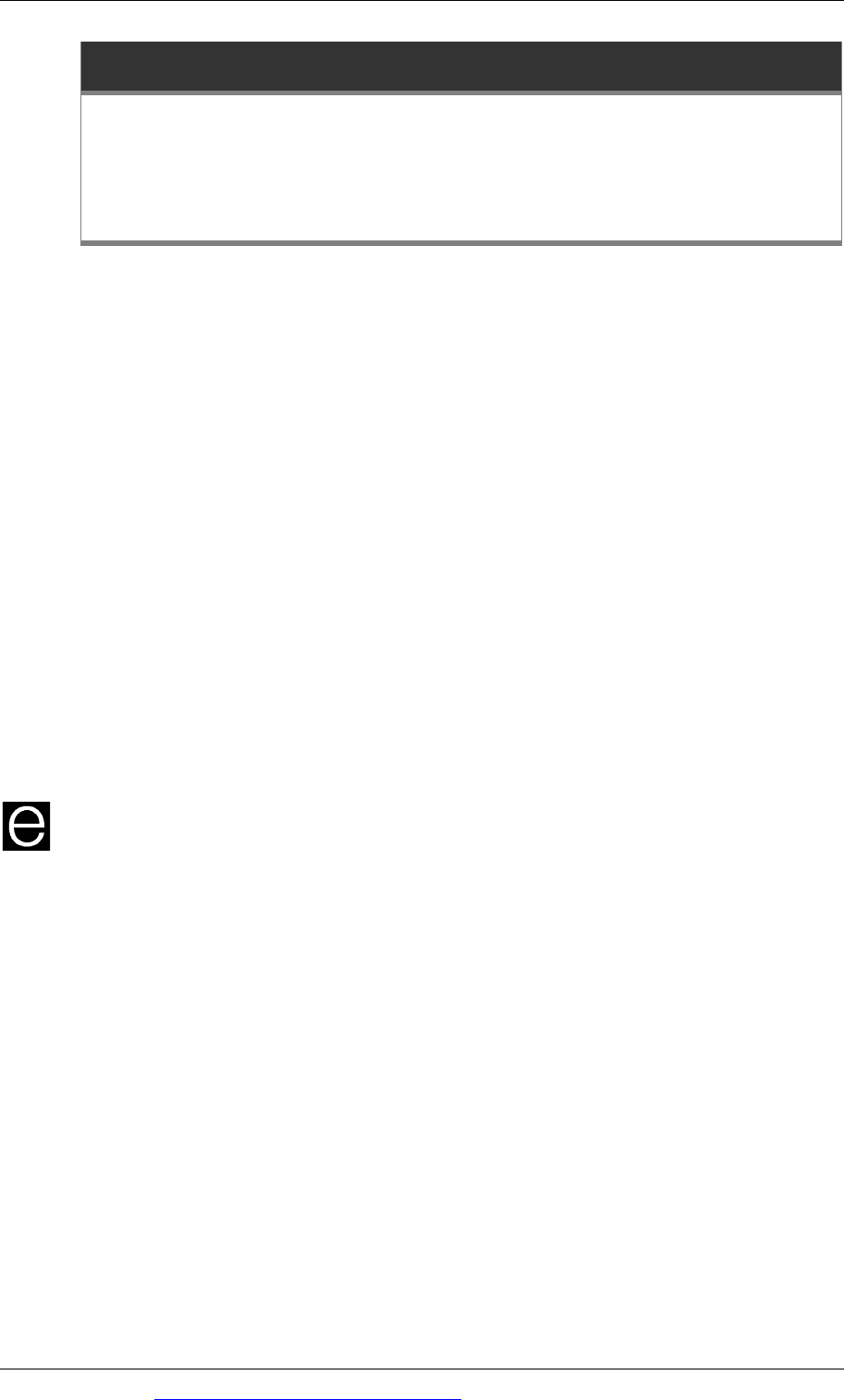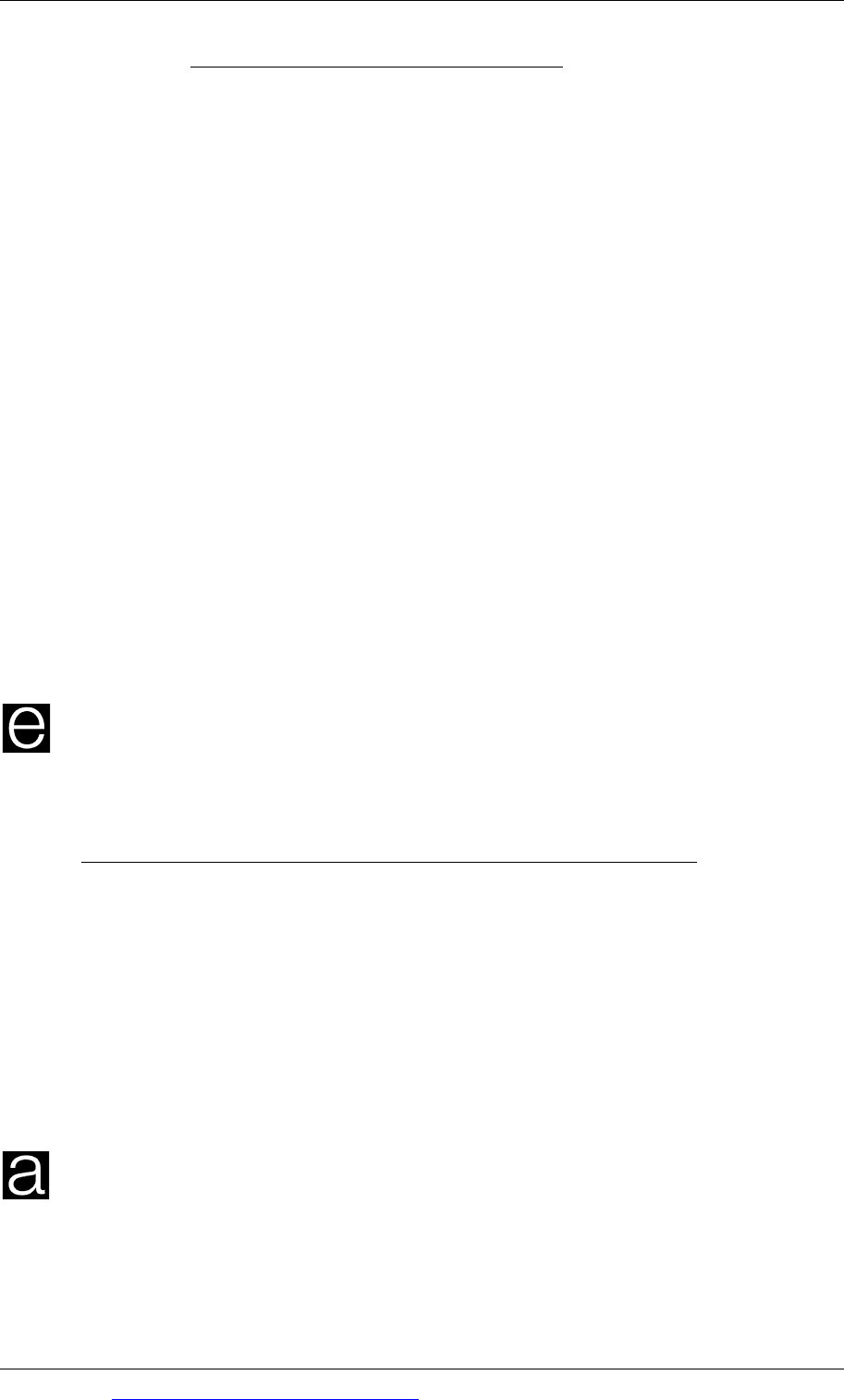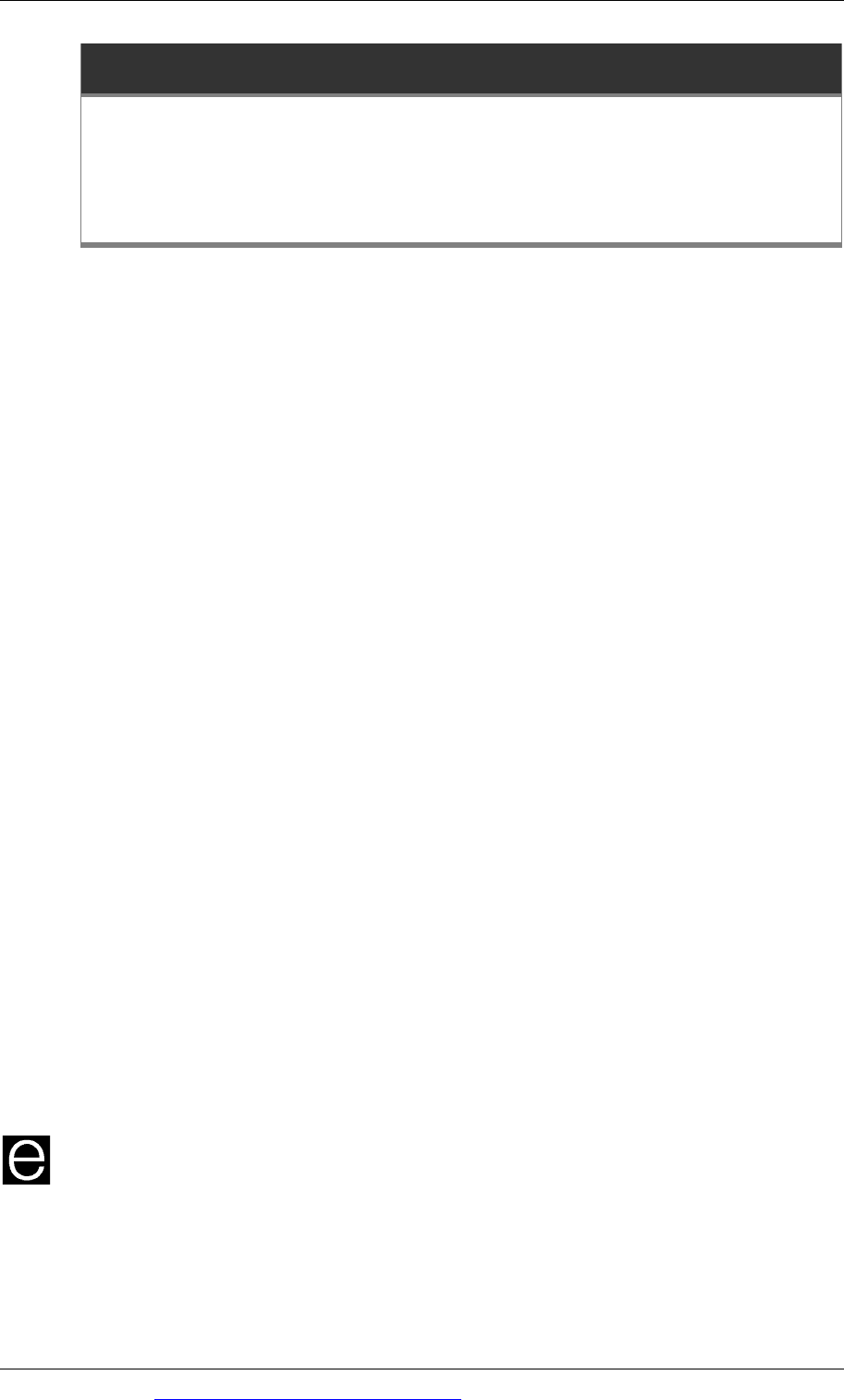ACCA F5 Performance Management - 2010 - Study text - Emile Woolf Publishing
Подождите немного. Документ загружается.


Chapter 13: Divisional performance
© EWP Go to www.emilewoolfpublishing.com for Q/As, Notes & Study Guides 345
Return on Investment (ROI)
The reason for using ROI as a financial performanc eindicator
Measuring ROI
ROI and investment decisions
Advantages and disadvantages of ROI for measuring performance
2 Return on Investment (ROI)
2.1 The reason for using ROI as a financial performance indicator
Return on investment (ROI) is a measure of the return on capital employed for an
investment centre. It is also called the accounting rate of return (ARR).
It is often used as a measure of divisional performance for investment centres
because:
the manager of an investment centre is responsible for the profits of the centre
and also the assets invested in the centre, and
ROI is a performance measure that relates profit to the size of the investment.
Profit is not a suitable measure of performance for an investment centre. It does not
make the manager accountable for his or her use of the net assets employed (the
investment in the investment centre).
Example
A company has two divisions which are treated as investment centres for the
purpose of performance reporting. Centre 1 has net assets of $5 million and made a
profit of $250,000. Centre 2 has net assets of $1 million and made a profit of
$150,000.
If the performance of the centres is compared on the basis of profits, the
performance of Centre 1 ($250,000) is better than the performance of Centre 2
($150,000). However Centre 1 employed assets of $5 million to earn its profit and its
ROI was just 5% ($350,000/$5 million). Centre 2 employed assets of just $1 million
and its ROI was 15%. Comparing performance on the basis of ROI, Centre 2
performed better.
2.2 Measuring ROI
Performance measurement systems could use ROI to evaluate the performance of
both the manager and the division. ROI is the profit of the division as a percentage
of capital employed.

Paper F5: Performance management
346 Go to www.emilewoolfpublishing.com for Q/As, Notes & Study Guides © EWP
ROI = Profit
Capital employed (size of investment)
ROI can be measured in different ways, but for the F5 examination the
recommended measures are as follows:
Profit. This should be the annual accounting profit of the division, without any
charge for interest on capital employed. This means that the profit is after
deduction of any depreciation charges on non-current assets.
Capital employed/investment.
- This should be the sum of the non-current assets used by the division plus
the working capital that it uses. Working capital = current assets minus
current liabilities, which for a division will normally consist of inventory
plus trade receivables minus trade payables.
- An examination question may ignore working capital in the figures that it
provides. If so, capital employed will consist of non-current assets only.
- Non-current assets could be measured at their initial cost. However, it is
more usual to measure non-current assets at their carrying value, which in
an examination question is likely to be at cost less accumulated
depreciation.
- Capital employed may be the capital employed at the beginning of the
financial year, the end of the financial year or the average capital employed
for the year. Check an examination question carefully to establish which of
these is required.
Example
An investment centre has reported the following results.
Current
year
Previous
year
$000 $000
Sales 600 600
Gross profit 180 210
Net profit 24 30
Net assets at beginning of year 200 180
Required: Discuss the financial performance of the investment centre. ROI is
measured using net assets at the beginning of the year.
Answer
ROI should be used to measure the performance of the division, but other financial
ratios should also be used if appropriate. In this example, sales revenue growth in
the current year has been 0% and we can also measure the gross profit margin and
net profit margin.

Chapter 13: Divisional performance
© EWP Go to www.emilewoolfpublishing.com for Q/As, Notes & Study Guides 347
Current year Previous year
$000 $000
Gross profit margin (%) 30% 35%
Net profit margin (%) 4% 5%
ROI (24/200; 30/180) 12% 17%
ROI has fallen from 17% to 12%, which is a large fall. The total investment has
increased from $180,000 to $200,000 but there has been no increase in sales revenue
in spite of the bigger investment.
A reason for the fall in ROI is the fall in gross profit and the gross profit margin,
from 35% to 30%. Other costs have been reduced from $180,000 in the previous year
($210,000 - $30,000) to $156,000 in the current year ($180,000 - $24,000), but in spite
of the reduction in these costs, the net profit margin also fell from 5% to 4%.
The failure to achieve any growth in sales (in spite of an increase in investment) and
the fall in gross profit margin are the reasons for the deterioration in financial
performance, as measured by ROI. This could be caused by intense competition in
the market in the current year (resulting in lower prices but no revenue growth),
although there is a possibility that the cost of sales are out of control.
2.3 ROI and investment decisions
The performance of the manager of an investment centre may be judged on the basis
of ROI – whether the division has succeeded or not in achieving a target ROI for the
financial year, or whether ROI has improved since the previous year.
If an incentive scheme is in operation, a divisional manager may receive a bonus on
the basis of the ROI achieved by the division.
Investment centre managers may therefore have a strong incentive to improve the
ROI of their division, and to avoid anything that will reduce the ROI. This can be a
serious problem when investment decisions are involved. When an investment
centre manager’s performance is evaluated by ROI, the manager will probably be
motivated to make investment decisions that increase the division’s ROI in the
current year, and reject investments that would reduce ROI in the current year.
The problem is that investment decisions are made for the longer term, and a new
investment that reduces ROI in the first year may increase ROI in subsequent year.
An investment centre manager may therefore reject an investment because of its
short-term effect on ROI, without giving proper consideration to the longer term.
Example
A division has net assets of $800,000 and makes an annual profit of $120,000. It
should be assumed that if the investment described below is not undertaken, the
division will continue to have net assets of $800,000 and an annual profit of $120,000
for the next four years.

Paper F5: Performance management
348 Go to www.emilewoolfpublishing.com for Q/As, Notes & Study Guides © EWP
The divisional is considering an investment in a new item of equipment that would
cost $80,000. The estimated life of the equipment is four years with no residual
value. The estimated additional profit before depreciation from the investment is as
follows:
Year $
1 20,000
2 25,000
3 35,000
4 40,000
The asset will be depreciated on a straight-line basis.
Required: What would be the ROI on this investment? ROI should be measured on
the basis of the average net assets employed during the year.
Would the investment centre manager decide to undertake this investment or not?
Answer
The annual profit from the investment, allowing for depreciation of $20,000 per
year, and the annual ROI of the division would be as follows:
Year
Profit without
the investment
Extra profit from
the investment
Total
profit
Net
assets
ROI
$ $ $
$
1 120,000 00 120,000
870,000 13.8%
2 120,000 5,000 125,000
850,000 14.7%
3 120,000 15,000 135,000
830,000 16.3%
4 120,000 20,000 140,000
810,000 17.3%
Note: Net assets are $800,000 plus the net assets for the new investment. The net
asset value of the new investment is $80,000 at the beginning of Year 1, $60,000 at
the beginning of Year 2 and so on down to $0 at the end of Year 4. Average net
assets are therefore $70,000 in Year 1, $50,000 in Year 2, $30,000 in Year 3 and
$10,000 in Year 4.
Without the new investment, the annual ROI would be 15% (= $120,000/$800,000).
The new investment would therefore reduce ROI in the first and second years, and
increase ROI in Year 3 and Year 4. It is therefore probable that the divisional
manager, if he is more concerned about financial performance in the short term, will
decide that the investment should not be undertaken, even though over a four-year
period the investment may be worthwhile.

Chapter 13: Divisional performance
© EWP Go to www.emilewoolfpublishing.com for Q/As, Notes & Study Guides 349
Note. Investment decisions should not be taken on the basis of ROI, even though
divisional managers are often tempted to do so. We can, however, calculate the
average ROI from this proposed investment:
$
Total 4-year profits before depreciation 120,000
Depreciation over four years 80,000
Total profit over 4 years 40,000
Average annual profit from the investment 10,000
Average asset carrying value over 4 years:
80,000
+
0
2
= $40,000
Average ROI = $10,000/$40,000 = 25%.
This is higher than the ROI of 15% achieved from the division’s other assets.
2.4 Advantages and disadvantages of ROI for measuring performance
Advantages of using ROI
There are several advantages in using ROI as a measure of the performance of an
investment centre.
It relates the profit of the division to the capital employed, and the division
manager is responsible for both profit and capital employed.
ROI is a percentage measure and can be used to compare the performance of
divisions of different sizes.
It is an easily understood measure of financial performance.
It focuses attention on capital as well as profit, and encourages managers to sell
off unused assets and avoid excessive working capital (inventory and
receivables).
Disadvantages of using ROI
There are also disadvantages in using ROI as a measure of the performance of an
investment centre.
As explained above, investment decisions might be affected by the effect they
would have on the division’s ROI in the short term, and this is inappropriate for
making investment decisions.
There are different ways of measuring capital employed. ROI might be based on
the net book value (carrying value) of the division at the beginning of the year,
or at the end of the year, or the average for the year. Comparison of performance
between different organisations is therefore difficult.
When assets are depreciated, ROI will increase each year provided that annual
profits are constant. The division’s manager might not want to get rid of ageing

Paper F5: Performance management
350 Go to www.emilewoolfpublishing.com for Q/As, Notes & Study Guides © EWP
assets, because ROI will fall if new (replacement) assets are purchased. This
point is explained in a later section of this chapter.
ROI is an accounting measure of performance. An alternative system of
performance measurement that includes non-financial performance indicators,
such as a balanced scorecard approach, might be more appropriate.

Chapter 13: Divisional performance
© EWP Go to www.emilewoolfpublishing.com for Q/As, Notes & Study Guides 351
Residual income (RI)
Measuring residual income
Imputed interest (notional interest) and the cost of capital
Residual income and investment decisions
Advantages and disadvantages of residual income
3 Residual income (RI)
3.1 Measuring residual income
Residual income (RI) is another way of measuring the performance of an investment
centre. It is an alternative to using ROI.
Residual income = Divisional profit minus Imputed interest charge.
Note
Divisional profit
is an accounting measurement of profit, after depreciation charges
are subtracted. It is the same figure for profit that would be used to measure ROI.
3.2 Imputed interest (notional interest) and the cost of capital
Residual income is calculated by deducting an amount for imputed interest (also
called notional interest) from the accounting profit for the division.
The
interest charge is calculated by applying a cost of capital to the division’s net
investment (net assets). The most appropriate measure of net investment is the
average investment during the period, although an exam question may instruct you
to calculate the interest charge on net assets at the beginning of the year.
Imputed interest (notional interest) is the division’s capital employed, multiplied by:
the organisation’s cost of borrowing, or
the weighted average cost of capital of the organisation, or
a special risk-weighted cost of capital to allow for the special business risk
characteristics of the division. A higher interest rate would be applied to
divisions with higher business risk.
Example
The same example that was used in the previous section to illustrate ROI will be
used here to illustrate residual income.
An investment centre has reported the following results.

Paper F5: Performance management
352 Go to www.emilewoolfpublishing.com for Q/As, Notes & Study Guides © EWP
Current year Previous year
$000 $000
Sales 600 600
Gross profit 180 210
Net profit 24 30
Net assets at beginning of year 200 180
The division has a cost of capital of 10%, which is applied to net assets at the
beginning of the year to calculate notional interest.
Required
: How would the financial performance of the investment centre be
assessed if residual income is used as the main measure of performance?
Answer
The residual income of the division in each year is calculated as follows.
Current year Previous year
$000
$000
Profit 24,000
30,000
Notional interest
(10%
× $200,000)
(20,000)
(10% × $180,000)
(18,000)
Residual income 4,000
12,000
Residual income has fallen from $12,000 in the previous year to $4,000 in the current
year. This indicates deterioration in divisional performance, although the residual
income is still positive. This means that the division’s profits exceed its cost of
capital.
An analysis of gross profit margin, net profit margin and sales growth (0%) will
indicate the causes of the fall in residual income.
3.3 Residual income and investment decisions
One reason for using residual income instead of ROI to measure a division’s
financial performance is that residual income has a money value, whereas ROI is a
percentage value. A company may prefer to measure performance in money terms.
In most other respects, however, residual income is similar to ROI as a measure of
divisional performance.
Example
The difference between ROI and residual income can be illustrated by returning to
the previous example that was used to illustrate the effect of ROI on investment
decision-making.

Chapter 13: Divisional performance
© EWP Go to www.emilewoolfpublishing.com for Q/As, Notes & Study Guides 353
A division has net assets of $800,000 and makes an annual profit of $120,000. It
should be assumed that if the investment described below is not undertaken, the
division will continue to have net assets of $800,000 and an annual profit of $120,000
for the next four years. The division’s financial performance is measured using
residual income, and the division’s cost of capital is 12%.
The divisional is considering an investment in a new item of equipment that would
cost $80,000. The estimated life of the equipment is four years with no residual
value. The estimated additional profit before depreciation from the investment is as
follows:
Year $
1 20,000
2 25,000
3 35,000
4 40,000
The asset will be depreciated on a straight-line basis.
Required: What would be the annual residual income on this investment? Notional
interest should be calculated on the basis of the average net assets employed during
the year.
Would the investment centre manager decide to undertake this investment or not?
Answer
Year 1 Year 2 Year 3 Year 4
Workings: notional interest
$ $ $ $
Average investment 870,000
850,000
830,000 810,000
Notional interest at 12% 104,400
102,000
99,600 97,200
Calculation of residual
income
$ $ $ $
Profit without investment 120,000
120,000
120,000 120,000
Additional profit before
depreciation
20,000
25,000
35,000 40,000
Additional depreciation (20,000)
(20,000)
(20,000) (20,000)
Divisional profit 120,000
125,000
135,000 140,000
Notional interest
(see workings)
(104,400)
(102,000)
(99,600) (97,200)
Residual income 15,600
23,000
35,400 42,800

Paper F5: Performance management
354 Go to www.emilewoolfpublishing.com for Q/As, Notes & Study Guides © EWP
If the investment is not undertaken, the residual income in each year would be:
$
Profit without investment 120,000
Notional interest (12% × $800,000)
(96,000)
Residual income 24,000
If the investment is undertaken, residual income would fall in Year 1 and Year 2, but
increase in Year 3 and Year 4. If the divisional manager is most concerned about
short-term financial performance, he would decide that the investment should not
be undertaken, in spite of the longer-term addition to residual income.
3.4 Advantages and disadvantages of residual income
Advantages of residual income
There are several advantages in using residual income as a measure of the
performance of an investment centre.
It relates the profit of the division to the capital employed, by charging an
amount of notional interest on capital employed, and the division manager is
responsible for both profit and capital employed.
Residual income is a flexible measure of performance, because a different cost of
capital can be applied to investments with different risk characteristics.
Disadvantages of residual income
There are also disadvantages in using residual income as a measure of the
performance of an investment centre.
Residual income is an accounting-based measure, and suffers from the same
problem as ROI in defining capital employed and profit.
Its main weakness is that it is difficult to compare the performance of different
divisions using residual income. Larger divisions should earn a bigger residual
income than smaller divisions. A small division making residual income of
$50,000 might actually perform much better than a much larger division whose
residual income is $100,000, if performance s measured by ROI. This point is
illustrated in the example below.
Residual income is not easily understood by management, especially managers
with little accounting knowledge.
Example
A company has two divisions, Small and Big. Big Division has net assets of $8
million and makes an annual profit of $900,000. Small Division has net assets of
$400,000 and makes an annual profit of $90,000. The cost of capital for both divisions
is 10%.
